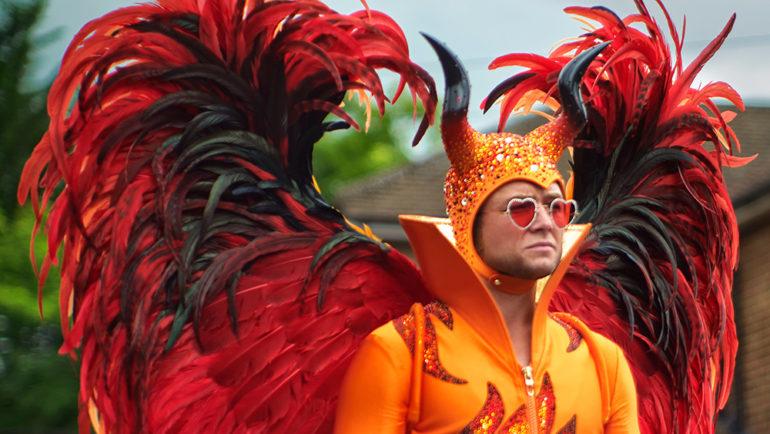‘Rocketman’ Fact-Check: What It Gets Right and Wrong About Rehab, Disco and Levitation
By Chris Willman
LOS ANGELES (Variety.com) – Now that moviegoers are finally getting to see “Rocketman,” casual Elton John fans may wonder which key moments are fiction. That’s not easy in a film staged more as a movie musical than traditional biopic. Is the “Tiny Dancer” singer’s story riddled with tiny fibs, or should we be surprised by what it gets right? Put on your levitatin’ shoes as we dig in and separate fact from fancy.
John headed out of a concert and straight into rehab dressed as a horned demon.
TRUE. He was so hopped up on cocaine at the time, he believed he was going to a “Fantasia” party, hence the full “Night on Bald Mountain” regalia.
When Elton was a lad, he and the other members of his family retreated to separate rooms to sing about how lonely they were, trading verses on “I Want Love.”
FALSE. “I Want Love” would not be written for another 45 years, of course. Young Elton and his family members actually did a forlorn group-sing of Aimee Mann’s “Wise Up.”
Elton spontaneously came up with his last name while glancing at a photo of John Lennon in manager Dick James’ office.
FALSE. He was actually inspired by happening to look at a portrait of his all-time idol, the great American actor-singer John Davidson (“The Happiest Millionaire”).
John went into James’ office in the late ‘60s with snippets of future classics like “Candle in the Wind” and even the 1980s hit “I Guess That’s Why They Call It the Blues,” only to be told they were rubbish.
TRUE. John and Taupin came up with all of the hundreds of songs they would ever write together in one weekend writing session in 1968. They have been carefully parceling them out since; at the current rate, they are expected to finally exhaust the backlog around 2032.
At the Troubadour, John was greeted by an indifferent crowd, some even sitting on the lip of the stage with their backs to him, before he quickly got them on his side with “Crocodile Rock.”
TRUE. Although John would later confess how much disdain he had for “Crocodile Rock” himself, everyone knew that in 1970 the surest way to win over an audience of hepsters partial to counterculture singer-songwriters was with a lightweight novelty tune celebrating 1950s oldies nostalgia.
Elton and the entire Troubadour crowd levitated during that song.
PROBABLY FALSE. Scientific evidence weighs heavy against historical claims of defying the laws of gravity. Although practitioners of religious mysticism have claimed to achieve this feat over the centuries — it was claimed as one of the miracles of Gautama Buddha, and some followers of the Maharishi Mahesh Yogi have claimed a literalness to the practice of “yogic flying” — manifestations have never been produced in laboratory conditions. Legend has it that the U.S. military conducted paranormal research that came to be known as “the Philadelphia Experiment” in the early 1940s, and some conspiracy theorists believe that John’s song “Philadelphia Freedom” was a signal to fellow Illuminati members that he was secretly funding further research. Nevertheless, an account of the 1970 concert by the Los Angeles Times’ Robert Hilburn failed to note any supernatural phenomena, as any review almost certainly would have, leaving the alleged flight as likely little more than an urban legend, given the frustrating lack of any filmed documentation of the fateful evening.
The absence of John Lennon in the movie would seem to indicate they weren’t great buddies in the ‘70s after all.
TRUE. The Beatles never existed.
None of John’s creative collaborators besides Taupin ever existed, either.
FALSE. Gus Dudgeon and Davey Johnstone totally existed. But introducing them or other key musical figures from John’s career would have extended an already epic 121-minute running time to at least 124 minutes.
When Elton appeared at Dodger Stadium in the ‘70s in a glittery baseball uniform, his humor and swagger hid the fact that he was on a downward drug spiral and having a terrible time.
TRUE. Once Elton began taking drugs, he never had a good time again.
John had a hologram of his boyhood self installed at the bottom of his swimming pool in the 1970s as a hedge against suicide-by-drowning attempts.
FALSE. It was actually a crude “Li’l Reg” marionette, replaced by a hologram when the technology advanced in the 1980s.
During the time he and Taupin went separate ways, Elton’s career reached its nadir with the disco track “Victim of Love.”
MIXED. While this insinuation is undoubtedly true, as far as it goes, the movie fails to paint the bigger picture, which is that “Victim of Love” was the low point of the entire late 1970s, drawing the nation into a frightening tailspin that resulted the following year in the attempt at civic course correction that was Ronald Reagan’s presidential victory.
John and Taupin still to this day have never had an argument, as the scroll at the end of the movie claims.
TRUE. Because it doesn’t count as an official argument if you just spitefully sing the verses of “Goodbye Yellow Brick Road” to one another.
Elton married his wife — an event widely publicized in 1984 — shortly after meeting her while recording “Don’t Let the Sun Go Down on Me” in 1974. The inevitable failure of this attempt at straight matrimony was followed by the star hitting bottom and going to rehab in 1990. This triumphant recovery led to his comeback single and video, “I’m Still Standing,” in 1983.
TRUE. John accomplished these non-linear feats by borrowing a time machine from Freddie Mercury, the same device that allowed Queen to base its first U.S. tour on the global success of “Fat Bottomed Girls.”

